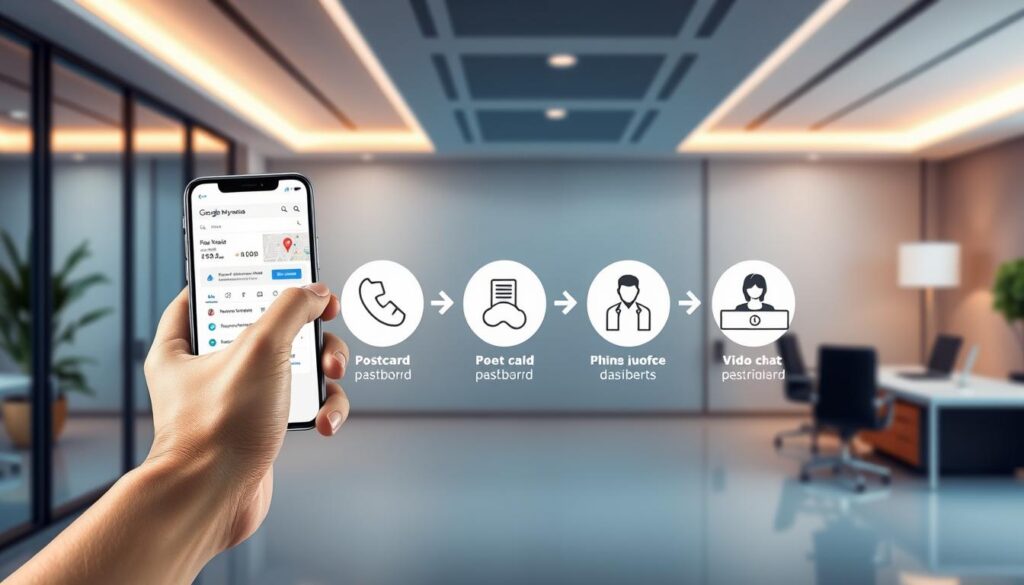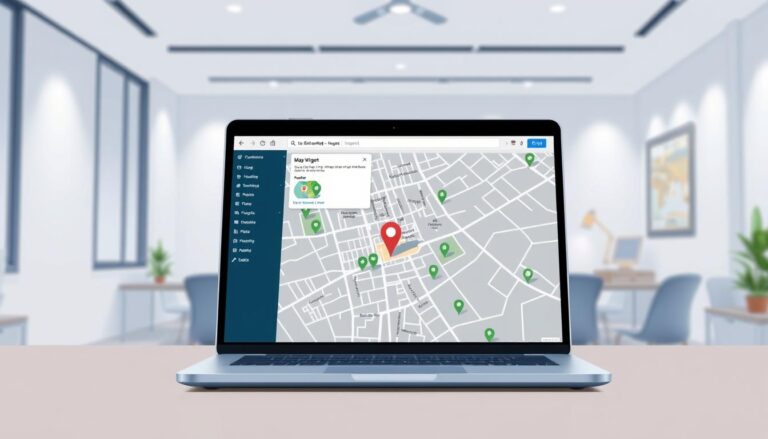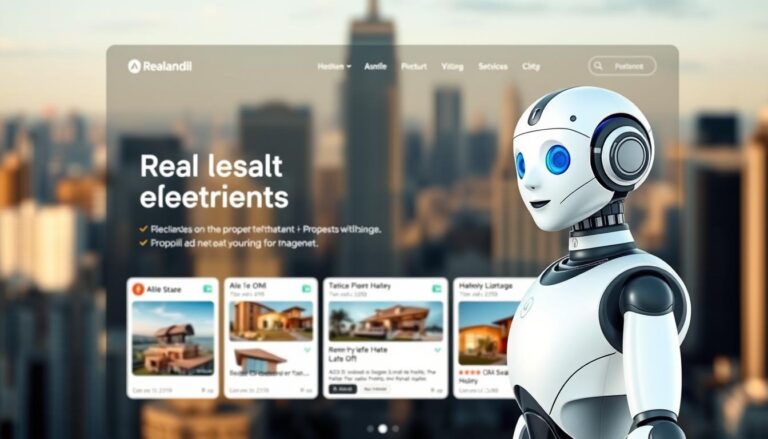Having a strong online presence is key, and it’s even more important for local businesses. Making sure your business listing is optimized is essential for better local search visibility. When your listing is current and correct, it makes it easier for people to find you.
As a business owner, I’ve seen how a well-optimized listing can bring more customers to your business. In this article, I’ll show you how to make your listing better to increase your online visibility.
Key Takeaways
- Understand the significance of local search visibility for your business.
- Learn how to claim and verify your business listing.
- Discover the importance of accurate and consistent business information.
- Find out how to optimize your listing with relevant categories and keywords.
- Understand the role of customer reviews in making your listing more visible.
Why Google My Business Matters for Local Businesses
For local businesses, having a Google My Business listing is now a must. In today’s world, being online is key to getting and keeping customers.
The Impact on Local Search Rankings
Google My Business greatly affects local search rankings. Businesses with full and correct listings show up more in local searches. This makes it easier for people to find them. It’s vital for getting more customers and sales.
How GMB Drives Customer Decisions
Google My Business shapes customer decisions by sharing important details like hours, reviews, and services. Good reviews and correct info build trust. This makes people more likely to pick your business over others.
Claiming and Verifying Your Google My Business Listing
To boost your business’s online presence, claiming and verifying your Google My Business listing is key. This step ensures your business info is correct and current. It also lets you control how your business shows up on Google Search and Maps.
Step-by-Step Claim Process
Claiming your Google My Business listing is easy. First, search for your business on Google My Business and click “Claim this business.” If it’s not listed, you can create a new one. You’ll need to verify your business by providing basic details like name, address, and category. Make sure your business info is accurate and the same everywhere online.
After you submit your claim, Google will check if you’re allowed to manage the listing. This usually takes a few days, but it can vary.
Verification Methods and Troubleshooting
After claiming, you’ll need to verify your listing. Google offers postcard verification, phone verification, and email verification. Postcard verification is the most common, where Google sends a postcard with a code to your address. If you’re having trouble, check that your business info is right. You can also find help on the Google My Business help center.

Completing Your Business Profile Information
I suggest filling out your Google My Business profile fully to boost your local SEO. A detailed profile makes you more visible in search results. It also helps customers find and understand your business.
NAP Details: Name, Address, Phone Number
It’s key to have your business’s Name, Address, and Phone Number (NAP) right and the same everywhere online. This info should match your website and other online listings. Wrong NAP details can mess up your local search rankings. For example, different phone numbers on different sites can hurt your credibility.
Business Description and Categories
Your business description should be clear and to the point. It’s also important to pick the right categories for your business. These categories help Google find your business when people search for things like yours. For example, a coffee shop might list itself as “coffee shop,” “cafe,” and “coffee store.”
Business Hours and Special Hours
Make sure to list your business hours, including any special times for holidays or events. Wrong or missing hours can upset customers and lead to bad reviews. For instance, a restaurant that doesn’t update its hours for a holiday might get unhappy customers who show up when it’s closed.
Products and Services
Listing your products and services on Google My Business lets customers see what you offer quickly. This can bring more relevant visitors to your business.
- Clearly describe your main products or services.
- Use keywords that customers might search for.
- Update this info regularly to show any changes in what you offer.
Google My Business Optimization Strategies
To make your Google My Business listing better, use several strategies. These can help you get more visibility and attract more customers. This can also increase your business’s profits.
Keyword Optimization in Your Profile
Keyword optimization is key for your Google My Business listing. Use relevant keywords in your business description and profile. This helps your listing show up in search results for those terms.
Choose keywords that customers might use when looking for your products or services. For example, if you have a bakery, use keywords like “custom cakes” or “artisanal bread.”
Service Area Settings
For businesses that don’t have a physical storefront, service area settings are important. By setting your service areas, your business will show up in search results for the right places. Make sure to check and update your service areas often to reflect any changes.
Attributes and Special Features
Google My Business lets you add attributes and special features to your listing. This gives customers more information about your business. Attributes might include “wheelchair accessible” or “free Wi-Fi.”
By highlighting these features, you can attract more customers who are looking for specific things.
Common Optimization Mistakes to Avoid
When optimizing your Google My Business listing, there are common mistakes to avoid. Don’t have inaccurate or inconsistent information in your listing or online. Also, avoid keyword stuffing in your business description, as it can harm your ranking.
Knowing these mistakes can help you optimize effectively and avoid penalties.
Visual Content: Photos and Videos
Visual content is key for a Google My Business listing. It lets businesses show off their products and services. High-quality photos and videos make the listing more engaging and attractive to customers.
Types of Images to Include
To make a Google My Business listing stand out, include different types of images. Show off your products, services, and company culture. Some must-haves are:
- Product or service showcases
- Company logos and branding
- Team members and employees
- Storefronts or office spaces
Photo Quality Guidelines
For clear and professional images, follow these guidelines. Use:
- High-resolution images
- Avoid low-light or poorly lit environments
- Ensure images are in focus
- Use relevant and accurate captions
Video Content Best Practices
Video content is powerful for showing off products and services. To make effective videos, remember:
- Keep videos short and concise
- Use high-quality audio and visuals
- Provide context and captions for videos
- Optimize video titles and descriptions with relevant keywords
By adding high-quality visual content, businesses can boost their Google My Business listing. This attracts more customers.
Managing and Responding to Customer Reviews
Managing reviews well is key to keeping a good online image. Reviews play a big role in what people think of your business. So, it’s important to handle and reply to them well.

How to Get More Reviews
To build a strong review profile, start by getting more reviews. Here are a few ways to do it:
- Give great service to make happy customers want to share their good experiences.
- Send out review request cards or email campaigns to ask for feedback.
- Make it simple for customers to leave reviews by giving them a direct link to your Google My Business page.
Responding to Positive Reviews
Replying to positive reviews shows you value customer feedback. It also makes customers feel good about their choice. Here’s how to do it right:
- Thank the customer for their feedback.
- Personalize the response by mentioning specific details from the review.
- Encourage the customer to come back or tell others about your business.
Handling Negative Feedback Professionally
Dealing with negative feedback in a professional way is vital. It helps keep your business reputation positive. Here’s how to handle it:
- Respond quickly to show you care about customer feedback.
- Acknowledge the customer’s concern and apologize for any trouble.
- Offer a solution or compromise to fix the problem.
By managing and responding to customer reviews well, businesses can improve their online image. This can help attract more customers.
Leveraging GMB Posts and Updates
To make the most of your Google My Business listing, using GMB posts and updates is key. GMB posts let businesses share updates, promotions, and events right on their listing. This boosts customer interaction and sales.
Types of Posts and When to Use Them
GMB has different post types, like events, offers, and updates. Use events for upcoming events or webinars. Offers are great for special deals or discounts. Updates are for sharing news, new products, or services.
- Use events to promote conferences, workshops, or sales.
- Utilize offers to drive sales during holiday seasons or special promotions.
- Share updates to keep customers informed about new products or company news.
Creating Engaging Content for GMB
To make engaging GMB posts, focus on visually appealing content and clear messaging. Use high-quality images and short descriptions to grab your audience’s attention.
Using Special Offers and Events
Special offers and events can really boost customer engagement. Create limited-time offers to push for immediate action. Promote events to increase attendance.
Post Scheduling and Frequency
Being consistent with GMB posting is important. Try to post at least once a week. But don’t flood your audience. Mix up your post types to keep things interesting.
Tracking Performance and Taking Your Listing to the Next Level
To make your Google My Business listing better, track its performance often. Google My Business insights show how people interact with your listing. This includes what they search for, what actions they take, and how they engage with your business.
By looking at these insights, you can find ways to improve. For example, if many people search for a certain service, highlight it in your description and posts. This way, you can attract more people interested in that service.
To enhance your listing, update it regularly with new content. Also, respond quickly to customer reviews and use GMB posts to connect with your audience. These steps will help you improve your listing and draw more customers to your business.










